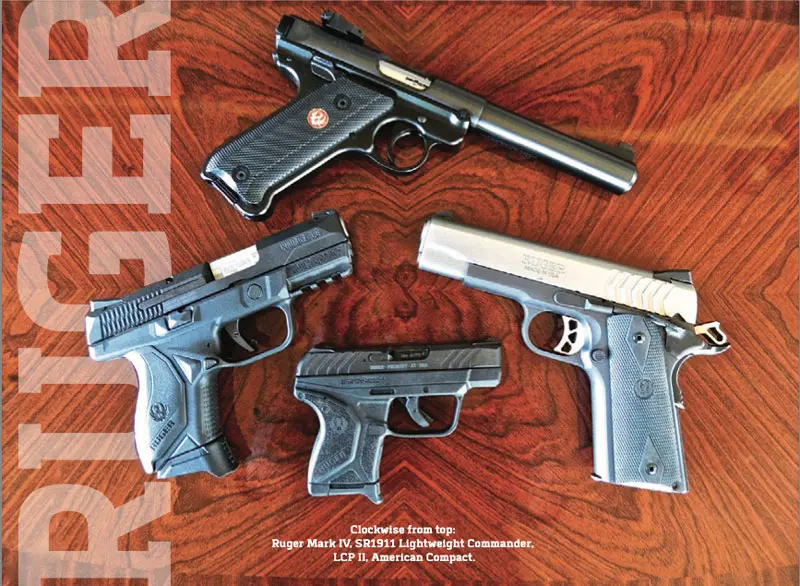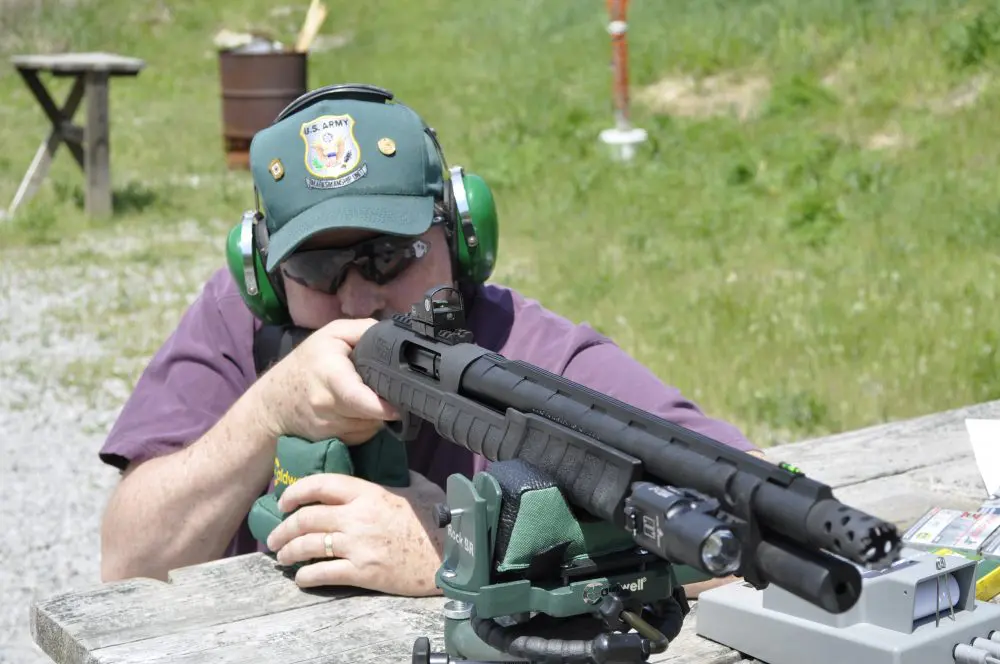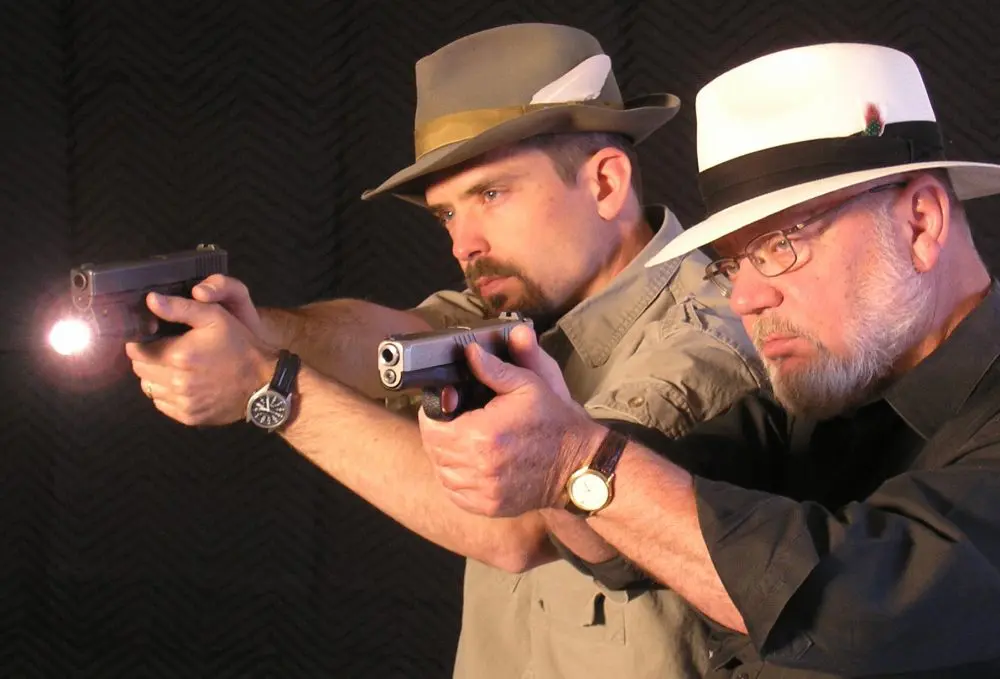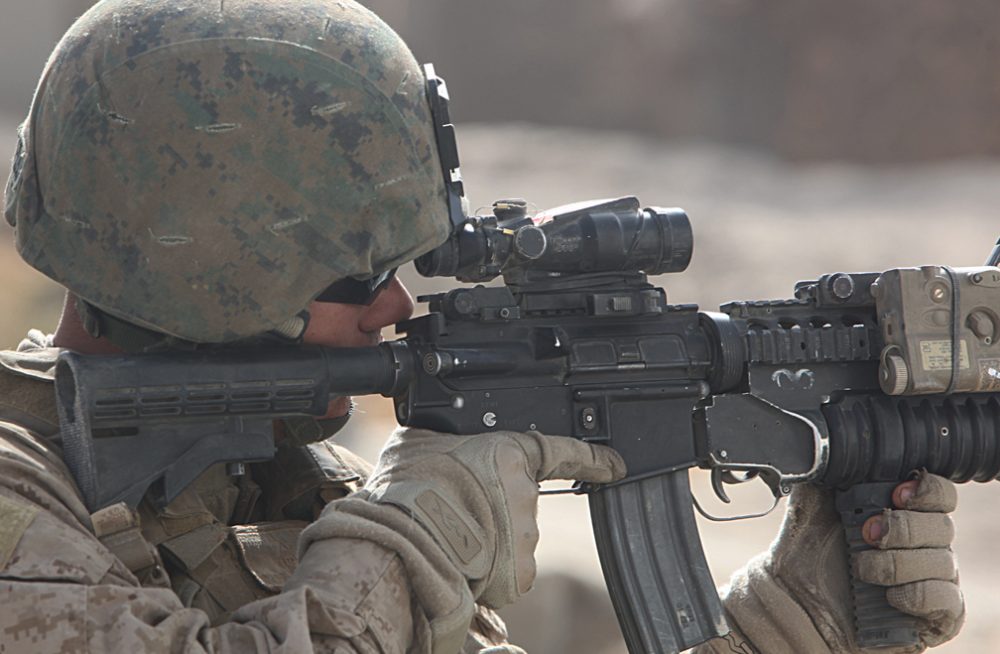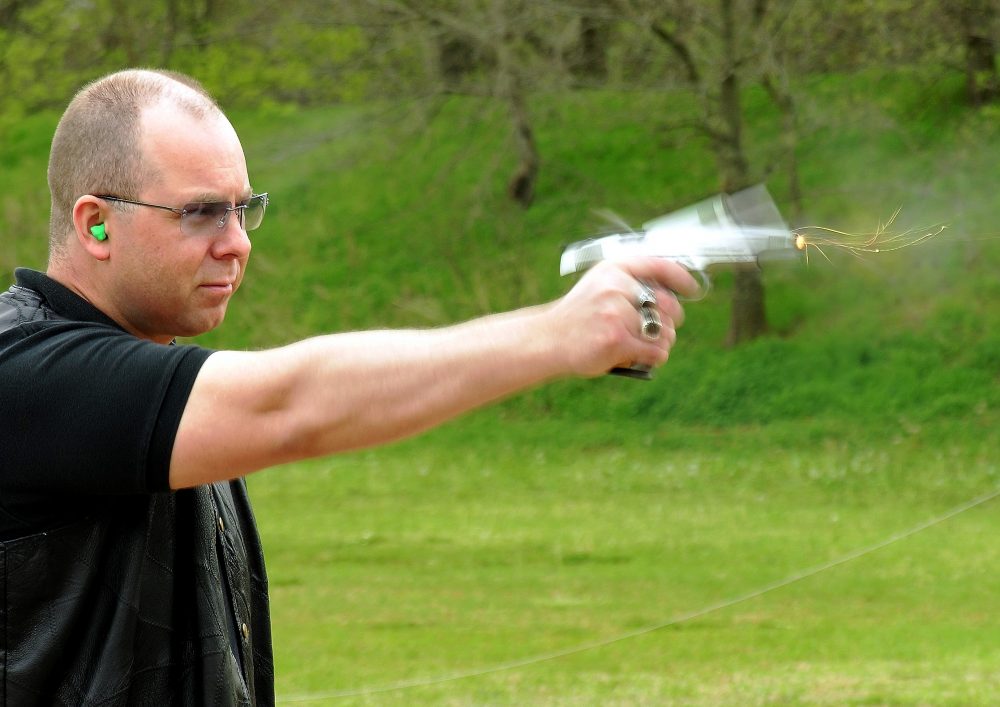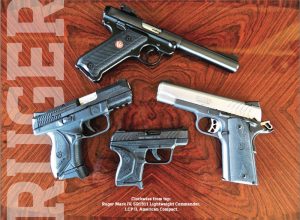
Ruger has become noted for not sitting on their laurels but instead listening to what their customers want—and then delivering. Late in the third quarter of 2016, the company released four new pistols: one .22, a .380, and two 9mms.
I received all four before they were officially released and also attended a five-day press event at FTW Ranch in Texas where gun writers were not only afforded the opportunity to shoot the pistols, but also to attend a condensed pistol course taught by Dave Spaulding from Handgun Combatives.
I’ll cover the pistols in the order they were officially introduced to the public.
Table of Contents
SR1911 LIGHTWEIGHT COMMANDER-TYPE
Recently a very good friend contacted me and related that his nephew was going to buy his first 1911 and intended to use it for general plinking and defense.
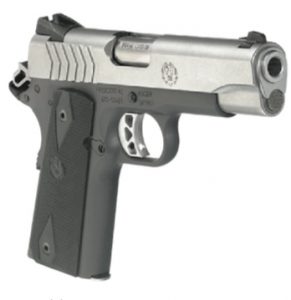
He would also likely attend some handgun courses with it, and he wanted my opinion on what to buy. My answer was immediate and unequivocal: Ruger.
I own a full-size and a Commander-size Ruger 1911 chambered in .45 ACP and have shot many more, including taking courses with them. While nothing manmade is perfect, I have yet to experience my first stoppage with a Ruger 1911.
The 9mm Luger cartridge is becoming more prevalent in all platforms, mostly due to advances in bullet design. And while I still believe bigger bullets are better, I have no qualms about carrying a 9mm with a proven load.
The new SR1911 Lightweight Com- mander-Type is of the original classic Series 70 design. The pistol has a stainless steel slide topped with genuine Novak® 3-Dot sights. Both are installed in dovetails, making them drift adjustable. The rear of the slide has grasping grooves with a unique chevron design.
On most 1911s, both the barrel and frame comprise the feed ramp. The Ruger has extended the feed ramp on the stainless steel barrel down, so the aluminum frame won’t get beat up. Kudos. The aluminum frame has a dark gray anodized finish. The beavertail grip safety allows a high grip that mitigates felt recoil. Stocks (grips) are checkered black rubber in the double diamond pattern. The hammer has an oblong hole that looks good, cuts its weight down, and allows faster lock time. The thumb safety and slide lock levers are slightly extended.
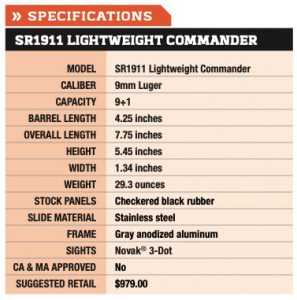
The aluminum skeletonized trigger has an adjustable overtravel screw. The 1911 pistol is legendary for a great trigger, and the test sample was no exception. According to my Lyman Electronic Trigger Gauge, the trigger broke cleanly and consistently— with no creep or noticeable overtravel—at 3.15 pounds. It was a joy to shoot.
The pistol ships in a cardboard box with a manual, trigger lock, and two nine-round stainless steel magazines.
A word about the magazines: The springs used in them are the stoutest I have ever encountered. The ninth round is difficult to seat and, for the first time ever, my left index finger became sore after loading only half-a-dozen mags.
I don’t believe this was an anomaly, as the magazines that came with the test pistol and those I used at FTW Ranch had the same substantial springs. Since I plan on keeping the test pistol and shooting it a lot, I’m going to in- vest in a magazine loader such as the UpLULATM loader sold on www.shopruger.com.
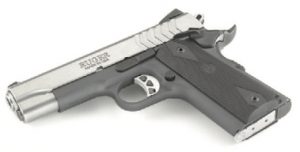
In contrast, the recoil spring used in the SR1911 Light- weight Commander is only ten pounds. I was a bit skeptical at first, but it worked well with everything from light loads to +P loads. On the plus side, the slide is very easy to manipulate for those with weak hands or suffering from arthritis.
I put about 500 rounds downrange through the Light- weight Commander at FTW Ranch and a like number through the test pistol on my home range with no stop- pages. The test pistol was a bit sluggish with no lubrication at the beginning of the evaluation, but Slip 2000 EWL got it running smoothly.
Accuracy was outstanding, capable of shooting into six inches at 25 yards standing unsupported.
MARK IV
Bill Ruger’s first pistol was the iconic Standard Model introduced in 1949. The Mark I came soon after in 1950 and continued production until 1981. It was the first pistol I ever owned. The Mark II ran from 1982 through 2005 with over three million sold.
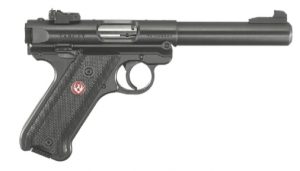
The Mark III added a few changes that included moving the magazine release from the bottom of the grip to behind the trigger guard, and adding a magazine disconnect and an internal safety lock that locked the pistol on safe with a provided key. It was produced from 2004 until 2016.
In my opinion, the new Mark IV is the best of all examples of the line. There are two versions of the Mark IV: the Hunter and the Target. The Hunter is the high-end version and features a stainless steel frame, stainless steel fluted bull barrel, adjustable rear sight, fiber-optic front sight, and checkered laminate stocks. At the risk of sounding like a fanboy, it is a beautiful pistol.
The Target has an aluminum frame; alloy steel, full-contour bull barrel; adjustable rear sight; front sight; and checkered plastic stocks. The test pistol was the Target version.
Improvements on the Mark IV start with the safety selector. Gone is the round button of past models, replaced with a lever. It is more ergonomic and is ambidextrous.
The slide release is also a lever on the Mark IV, making it easier to manipulate. The bolt stays to the rear when the last round is fired.
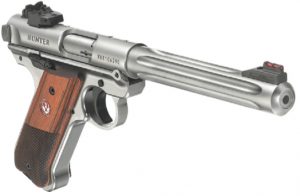
A spring-loaded plunger at the bottom of the frame is depressed when a magazine is inserted. When the magazine release is pressed, the magazine ejects easily out of the magazine well, even when held parallel to the deck.
One common complaint with earlier models was that they could be difficult to reassemble. The bolt stop pin and hammer strut could be tricky to align perfectly. When the housing latch was snapped into place, SOP was to pull the bolt to the rear. If it went to the rear, you were good to go. If not, the process had to be repeated.
The Mark IV greatly simplifies takedown and reassembly: just press on a single button located at the rear of the frame. When pressed, the upper receiver/barrel group swings open much like an AR. To reassemble, line up the frame and up- per receiver and press them together. Simple.
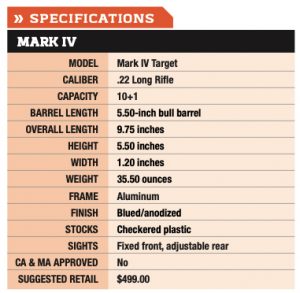
Accuracy was nothing short of outstanding. At FTW Ranch, I went six for ten, standing unsupported, on a 12- inch steel plate at 160 yards on my first try. I really expected more drop out of the .22 at that distance and was holding high for the first four rounds. Using a standard sight picture at the top edge of the plate resulted in the gratifying sound of lead striking steel.
The test pistol exhibited similar accuracy on my home range. The trigger broke cleanly at 5.6 pounds with a short take-up and no discernible overtravel.
The Mark IV ships in a cardboard box complete with manual, trigger lock, and two ten-round magazines.
LCP II
When Ruger introduced the LCP (Lightweight Compact Pistol) in 2008, it changed the way people viewed pocket pistols. Extremely concealable and light, it was also very reliable. It was almost single- handedly responsible for the scarcity of .380 ACP ammo on dealers’ shelves.
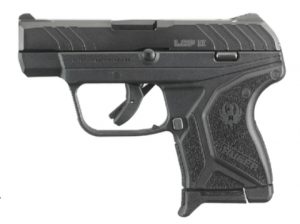
The main complaints about the pistol were its extremely miniscule sights, the slide was hard to pull back, the double-action-only trigger pull was stiff, and its thin profile on the backstrap would cause pain in the web of the hand after a few magazines.
While I realize many people carry LCPs and other pocket pistols as their primary concealed-carry arm, I prefer a full-size service pistol or a compact version of one, relegating the LCP, for me, to status as a back-up piece.
If the situation has gone south to the point of having to transition to the back-up, one had better be very, very proficient with it. I practiced with my LCP a lot, putting 6,000 rounds downrange in the last eight and a half years, but I never really enjoyed it.
The new LCP II may change that.
To begin with, the LCP II is no longer double-action-only. It now uses a single-action striker-fired mechanism with an internal safety. The trigger on the test pistol broke between 6.1 and 6.6 pounds.
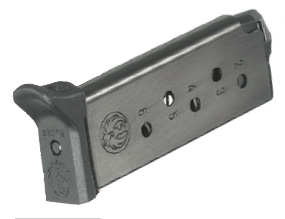
The slide is much easier to rack, which is quite important for folks with less hand strength or other problems. Grasp- ing grooves are present on both the fore and aft sides of the slide. An improved slide stop makes it easier to lock the slide to the rear.
The sights on a pocket pistol are necessarily small and smooth to prevent them from snagging when presenting the pistol. While the sights on the LCP II are still small, they are at least usable.
Finally, the LCP II’s grip texture has been improved and the backstrap area is wider.
In the course of evaluating the LCP II, I fired slightly over 200 rounds in one range trip. Even with the hottest .380 ACP load fired, the Winchester 95-grain PDX1, I felt no discomfort in the web of my hand.
Redesigned internally with a redesigned magazine, the slide stays to the rear when the last round is fired. Earlier LCP six-round magazines function in the LCP II but won’t hold the slide back. Seven-round LCP magazines do not function in the LCP II. The magazine ejected freely.
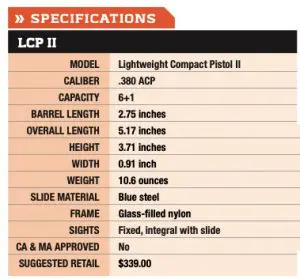
The original LCP came with a padded zippered case. The LCP II comes with a much more usable pocket holster, which is smooth on the inside with a suede-feel exterior and rub- ber-type strip. In testing, I found that it stayed in the pocket, while allowing a smooth draw.
The LCP II ships in a cardboard box with a manual, lock, and one six-round magazine with both flat and finger-ledge floorplates, and the above-mentioned holster.
Ruger refers to the LCP II as a “best in class” pocket pistol. With the improvements, and a suggested retail of $399, I think they’re right.
AMERICAN COMPACT
Ruger’s introduction of the Ameri- can Pistol in December 2015 took the gun world by storm. The American either met or exceeded all phases of the tests for a new American military service pistol. Now it’s available in a compact carry size.
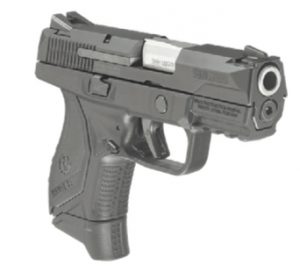
Ruger has released two versions of the American Compact Pistol (ACP): the PRO with no manual safeties and one with manual safeties. The test gun was the PRO model.
The slide is stainless steel and topped with genuine Novak LoMount Carry three-dot sights with a matte black nitride finish.
The rigid one-piece precision-machined stainless steel chassis with integral frame rails and fire-control housing is set into a high-performance glass-filled nylon grip frame. The dust cover has a mil-standard 1913 accessory rail.
The slide release, magazine release, and manual safeties (on the model with a manual safety) are fully ambidextrous.
The American line uses a pre-tensioned striker, resulting in one of the best—if not the best—striker-fired triggers I have used. The test gun’s trigger broke right at six pounds with a positive reset.
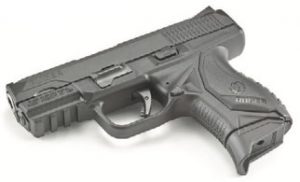
How a pistol fits a user is often overlooked but is a vital component when shooting. Like its big brothers, the ACP has a modular grip system and comes with large, medium, and small interchangeable backstraps to accommodate different-size hands and trigger reach.
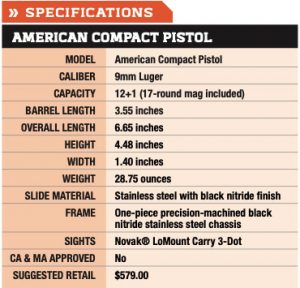
Unlike some pistols, the American does not require pressing the trigger to field strip it. Not having to press the bang switch to field strip is a good feature. While a firearm should be double-checked to ensure it’s unloaded before field stripping, there have been negligent discharges with one brand of pistol because the user either became distracted or just plain had a case of the stupids.
All controls on American Compact are completely ambidextrous.
The ACP ships in a fitted hard-sided plastic case and includes a manual and safety lock. Also included are two Nickel-Teflon® plated steel magazines—a 12-round magazine with a flat floorplate and finger-ledge floorplate, and a 17-round magazine. A sleeve that fits on the 17 rounder matches it seamlessly to the frame.
The American series has a recoil-reducing barrel cam, low-mass slide, low center of gravity, and low bore axis. This allows the pistol to balance well in the hand, with less felt recoil and muzzle flip than many pistols.
The ACP is rated for sustained use of +P ammunition, and it functioned perfectly with a wide variety of ammunition.
Firing slowly from a rest, the American Compact is capable of keeping all rounds into a 3×5 card at 25 yards. Maga- zines ejected effortlessly.
WHAT’S NEXT?
While at FTW Ranch, attendees were treated to a preview of several other new products that Ruger has planned for release. In fact, a few may have been introduced by the time you read this, and we will have comprehensive reports as they become available and we thoroughly test them.
For the latest updates, stay tuned to the S.W.A.T. Facebook page.
